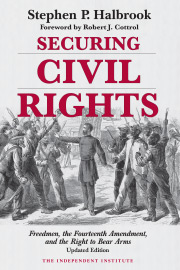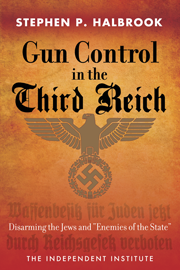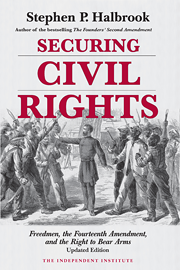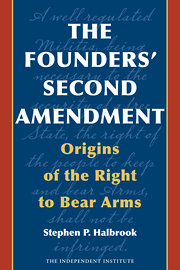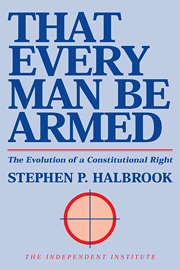Legitimate concerns exist about the selection of Judge Sonia Sotomayor for Justice on the U.S. Supreme Court with regard to the interests of the tens of millions of Americans who exercise Second Amendment rights. As an appellate judge, she participated in rendering decisions which expressed little regard for the constitutional right of the people to keep and bear arms.
On the U.S. Court of Appeals for the Second Circuit, Judge Sotomayor joined in two per curiam opinions that are adverse to Second Amendment interests. These opinions held that the Second Amendment does not protect a fundamental right, that the right does not apply to the States through the Fourteenth Amendment, and that one may be searched and arrested for the “crime” of mere possession of a firearm—the core right protected by the Second Amendment. Since a per curiam opinion is unsigned and is agreed to by a three-judge panel, Judge Sotomayor’s role in generating these opinions is unknown.
However, in another case, Judge Sotomayor dissented from an en banc opinion on the basis that judges should not pursue policy preferences by disparate sentences under the federal Gun Control Act. Her approach in that case, although it did not involve law-abiding gun owners, expressed a sense of fairness in deciding issues under the nation’s firearm laws.
Maloney v. Cuomo: Refusing to Consider Modern Supreme Court Precedent on Whether the Second Amendment Applies to the States Through the Fourteenth Amendment
Maloney v. Cuomo, 554 F.3d 56, 58 (2nd Cir. 2009) (per curiam), in which Judge Sotomayor joined, devoted a single paragraph to hold that a State prohibition on possession of a type of arm does not give rise to a cognizable claim under the Second Amendment. The court acknowledged that the Second Amendment “confers an individual right on citizens to keep and bear arms.” Id., citing District of Columbia v. Heller, 128 S. Ct. 2783, 2799 (2008). However, “the Second Amendment applies only to limitations the federal government seeks to impose on this right.” Id. at 58–59, citing Presser v. Illinois, 116 U.S. 252, 265 (1886), and Bach v. Pataki, 408 F.3d 75, 84, 86 (2d Cir. 2005), cert. denied, 546 U.S. 1174 (2006).
Yet Presser held only that the Second Amendment does not apply directly to the States. For that proposition it relied on United States v. Cruikshank, 92 U.S. 542, 552–53 (1876), which in turn was based on the pre-Fourteenth Amendment decision in Barron v. Mayor of Baltimore, 7 Pet. 243, 8 L. Ed. 672 (1833). While holding that neither the First nor Second Amendments applied directly to the States, Cruikshank and Presser did not consider whether those amendments applied to the States through the Fourteenth Amendment. Those cases were followed by Miller v. Texas, 153 U.S. 535, 538 (1894), which refused to consider whether the Second and Fourth Amendments apply to the States through the Privileges or Immunities Clause of the Fourteenth Amendment because the issue was not raised in the trial court.
To date, the Supreme Court has never ruled on whether the Second Amendment applies to the States through the Fourteenth Amendment. Yet the Second Circuit in Maloney, and before that in Bach, relied on Presser despite Presser being silent on the issue of whether the Second Amendment is incorporated into the Fourteenth Amendment so as to apply to the States.
The Supreme Court provided guidance in Heller, 128 S. Ct. 2813 n.23, as follows: “With respect to Cruikshank’s continuing validity on incorporation, a question not presented by this case, we note that Cruikshank also said that the First Amendment did not apply against the States and did not engage in the sort of Fourteenth Amendment inquiry required by our later cases.” These “later cases,” decided in the twentieth century, held most Bill of Rights guarantees to be incorporated through the Due Process Clause of the Fourteenth Amendment against State violation.[1]
While Bach was decided before Heller, Maloney was decided after, yet the latter refers to the above footnote 23 in Heller only for the proposition that “the case did not present the question of whether the Second Amendment applies to the states . . . .” 554 F.3d at 59. It wholly disregarded the admonition in footnote 23 to “engage in the sort of Fourteenth Amendment inquiry required by our later cases.”[2] It fails to discuss any of these later cases or even to acknowledge the Court’s directive. Why?
Maloney proceeds to state that “to the extent that Heller might be read to question the continuing validity of this principle, we ‘must follow Presser’” because it is binding Supreme Court precedent. 554 F.3d at 59. But as stated previously, “following” Presser means not applying the Second Amendment directly to the States. It does not mean ignoring the Court’s 2008 directive to “engage in the sort of Fourteenth Amendment inquiry required by our later cases.” 3 Heller, 128 S. Ct. 2813 n.23.
The Ninth Circuit conducted the required analysis and held that the Second Amendment is incorporated into the Fourteenth Amendment. Nordyke v. King, 563 F.3d 439 (9th Cir. 2009). The Seventh Circuit held that it was bound by Cruikshank and Presser and failed to engage in what it called “the Court’s selective (and subjective) approach to incorporation . . . .” National Rifle Ass’n v. City of Chicago, 567 F.3d 856, 858-59 (7 Cir. 2009), cert. petition filed, No. 08-1497 (June 3, 2009).[3]
Mr. Maloney has now filed a petition for a writ of certiorari. Maloney v. Cuomo, cert. petition filed, No. 08-1592 (June 26, 2009). In his petition, Maloney argues that the petition in NRA v. Chicago should be granted and that the cases should be consolidated. Maloney Pet. at 25.[4]
If confirmed, Judge Sotomayor will be faced with serious recusal issues. She was on the panel that decided Maloney v. Cuomo. She has acknowledged that “a conflict of interest would arise from any appeal arising from a decision issued by a panel of the Second Circuit that included me as a member,” and that in such a circumstance, expects that she “would address the actual or apparent conflict of interest by recusing myself from the case.”[5]
Given that Judge Sotomayor would recuse herself from Maloney and that Maloney seeks consolidation with NRA v. Chicago, would she also recuse herself from NRA v. Chicago? Would it depend on whether the cases are consolidated? Should the Court grant the writ in NRA v. Chicago and either hold or deny the writ in Maloney, would the ethical problem be the same, in that the issue in each case is whether the Second Amendment is incorporated into the Fourteenth Amendment? Judge Sotomayor has already decided that issue adversely on the Maloney panel.
In sum, Judge Sotomayor participated in deciding an issue now pending before the Supreme Court. She joined in a panel decision holding that persons have no federally-protected right to keep and bear arms free from State infringement. Were she to participate in either the certiorari decision or the merits decision in NRA v. Chicago, she would effectively be deciding whether to affirm or reverse her previous ruling, which is a clear conflict of interest.
United States v. Sanchez-Villar: Is Mere Possession of a Firearm Cause for Search and Arrest on the Basis that Keeping Arms is Not a Fundamental Right?
Judge Sotomayor joined in the panel decision in United States v. Sanchez-Villar, 99 Fed.Appx. 256, 258, 2004 WL 962938 (2nd Cir. 2004) (per curiam), vacated & remanded, Sanchez-Villar v. United States, 544 U.S. 1029 (2005) (for further consideration in light of United States v. Booker, 543 U.S. 220 (2005)). Sanchez-Villar held that mere possession of a firearm—which the Second Amendment guarantees—creates probable cause for a warrantless search, seizure, and arrest. The opinion states: “Under New York law, it is a crime to possess a firearm.” Id. Having a license is an affirmative defense the person must prove at trial. Since “the officers were lawfully located in a place from which they plainly could see the gun, the officers were justified in seizing it because of its ‘immediately apparent’ incriminating character.” Id. The court added about the pro se appellant, who was convicted of being an illegal alien in possession of a firearm:
We reject Sanchez-Villar’s argument that New York’s statutory scheme offends the Second Amendment of the United States Constitution. See U.S. Const. amend. II; United States v. Toner, 728 F.2d 115, 128 (2d Cir. 1984) (stating that “the right to possess a gun is clearly not a fundamental right”).
Id. at 258 n.1.
But like Sanchez-Villar, Toner involved an illegal alien in possession of firearms, not a law-abiding citizen. Toner stated about the defendant’s equal protection challenge to the ban on firearm possession by an illegal alien:
He concedes, however, that the statute passes constitutional muster if it rests on a rational basis, a concession which is clearly correct since the right to possess a gun is clearly not a fundamental right, cf. United States v. Miller, 307 U.S. 174, 59 S.Ct. 816, 83 L.Ed. 1206 (1939) (in the absence of evidence showing that firearm has “some reasonable relationship to the preservation or efficiency of a well regulated militia,” Second Amendment does not guarantee right to keep and bear such a weapon), and since illegal aliens are not a suspect class.
Toner, 728 F.2d at 128.
This statement in Toner is a slim reed on which to rely for the proposition that possession of a gun by anyone is not a fundamental right. First, this was a concession by the defendant without any reasoned analysis by the court. Second, nothing in the quotation from Miller addressed whether the right is fundamental—it spoke only to whether “the type of weapon at issue was not eligible for Second Amendment protection . . . . Beyond that, the opinion provided no explanation of the content of the right.” Heller, 128 S. Ct. at 2814. Indeed, Miller never used the term “fundamental right” or any equivalent term, and to the extent any judges went beyond its holding, “they overread Miller.” Heller, 128 S. Ct. at 2815 n.24. Third, given that illegal aliens have no rights under the Second Amendment, [6] it was pure dictum to imply that law-abiding citizens have no fundamental right to possess a firearm. On that last point, the Sanchez-Villar panel ignored an intervening Supreme Court precedent that superseded the Toner dictum. United States v. Verdugo-Urquidez, 494 U.S. 259, 265 (1990), made clear that Americans at large have Second Amendment rights but that illegal aliens do not:
“the people” seems to have been a term of art employed in select parts of the Constitution. . . . The Second Amendment protects “the right of the people to keep and bear Arms” . . . . While this textual exegesis is by no means conclusive, it suggests that “the people” protected by the Fourth Amendment, and by the First and Second Amendments, . . . refers to a class of persons who are part of a national community or who have otherwise developed sufficient connection with this country to be considered part of that community. See United States ex rel. Turner v. Williams, 194 U.S. 279, 292 (1904) (Excludable alien is not entitled to First Amendment rights, because “he does not become one of the people to whom these things are secured by our Constitution by an attempt to enter forbidden by law”).
Given that language, it was improvident for the panel in Sanchez-Villar to state generally that “the right to possess a gun is clearly not a fundamental right.” 99 Fed.Appx. at 258. Heller has since then dispositively ruled to the contrary: “By the time of the founding, the right to have arms had become fundamental for English subjects.” Id. at 2798.
Moreover, it seems dubious to suggest that it can be made a crime to exercise a core constitutional right—here, the right to keep arms—and that it is merely an affirmative defense that the defendant has a license. In almost every other State nationwide, it is not a crime merely to possess a firearm. A person who is not bothering anyone and who is known to possess a firearm peaceably cannot simply be searched and arrested. Under Terry v. Ohio, 392 U.S. 1, 30 (1968), to conduct a patdown search, police must have reason to believe a crime is afoot and that the suspect is armed and dangerous.
Accordingly, the decision in Sanchez-Villar raises substantial concerns not only under the Second Amendment, but also the Fourth Amendment. Hopefully Judge Sotomayor will address those concerns.
United States v. Cavera: Judges Must Not Follow Policy Preferences
United States v. Cavera, 550 F.3d 180 (2nd Cir. 2008) (en banc), upheld more prison time under the federal Gun Control Act of an army veteran over 70 years old for selling guns across state lines into New York City based on the theory that its strict gun laws created a large black market that required more severe penalties for deterrence. A concurring opinion would allow enhanced prison time based on the theory that guns are more dangerous in cities. Id. at 198 (Raggi, J., concurring).
Judge Sotomayor dissented on the basis that sentencing should be uniform nationwide and should not be based on policy arguments of judges.[7] What she wrote is significant on firearm law issues: “arbitrary and subjective considerations, such as a judge’s feelings about a particular type of crime, should not form the basis of a sentence. . . . Yet a serious danger exists that sentencing judges will dress their subjective views in objective trappings, either by using questionable empirical data or by invoking a ‘common sense’ at odds with reality.” Id. at 220 (Sotomayor, J., dissenting).
Judge Sotomayor would have held that “the district court’s analysis and data are insufficient to support its conclusion that defendant-appellant deserved a severer sentence because firearms trafficking (1) is a more serious crime in densely populated areas, and (2) requires greater deterrence in areas with restrictive gun laws.” Id. She further wrote that the data “do not show that a gun in New York City is more likely to hurt people than a gun elsewhere.” Id.
The Second Amendment was not an issue in Cavera. However, now that Heller has settled that the Second Amendment protects an individual right to keep and bear arms, will Judge Sotomayor decide Second Amendment and firearm law issues with the same approach she took in Cavera, to eschew “arbitrary and subjective considerations, such as a judge’s feelings about a particular type of crime”? Heller itself rejected a judicial “interest-balancing” test to the Second Amendment as follows:
We know of no other enumerated constitutional right whose core protection has been subjected to a freestanding “interest-balancing” approach. The very enumeration of the right takes out of the hands of government—even the Third Branch of Government—the power to decide on a case-by-case basis whether the right is really worth insisting upon. A constitutional guarantee subject to future judges’ assessments of its usefulness is no constitutional guarantee at all. Constitutional rights are enshrined with the scope they were understood to have when the people adopted them, whether or not future legislatures or (yes) even future judges think that scope too broad.
Heller, 128 S. Ct. at 2821.
Conclusion
Judge Sotomayor adhered to two per curiam decisions which gave short shrift to Second Amendment rights. In Maloney, the panel should have followed the admonition in Heller that, in evaluating whether the Second Amendment is incorporated into the Fourteenth Amendment, analysis of the Court’s modern cases is “required.” That issue is now before the Supreme Court in a petition for a writ of certiorari filed by Mr. Maloney and in a separate petition filed by the National Rifle Association in a case arising out of the Seventh Circuit. If confirmed, Judge Sotomayor should recuse herself from consideration of that issue.
In Sanchez-Villar, the panel disregarded Supreme Court precedent stating that “persons who are part of [our] national community,” but not illegal aliens, have rights under the Second Amendment, and instead opined that “the right to possess a gun is clearly not a fundamental right” for anyone. Serious Second and Fourth Amendment issues are raised by that court’s holding that the mere possession of a firearm is probable cause for a search, seizure, and arrest.
By contrast, Judge Sotomayor’s rejection of subjective policy preferences regarding firearm laws in Cavera is commendable. If confirmed, will she apply the same approach and take Second Amendment rights seriously? The tens of millions of Americans who choose to exercise their right to keep and bear arms anxiously await answers to their concerns.
Refrences
- Decisions incorporating substantive rights include Chicago B. & Q. R. Co. v. Chicago, 166U.S. 226 (1897) (just compensation); Gitlow v. New York, 268 U.S. 652, 666 (1925) (free speech and press); De Jonge v. Oregon, 299 U.S. 353, 364 (1937) (assembly); Cantwell v. Connecticut, 310 U.S. 296, 303 (1940) (freedom of religion); Everson v. Board of Education, 330 U.S. 1, 8 (1947) (establishment clause); Edwards v. South Carolina, 372 U.S. 229, 235 (1963) (petition). Some of the leading decisions on procedural rights are Wolf v. Colorado, 338 U.S. 25, 27-28 (1949), rev’d. on other grounds, Mapp v. Ohio, 367 U.S. 643 (1961) (search and seizure); Duncan v. Louisiana, 391 U.S. 145, 147-48 (1968) (jury trial); Benton v. Maryland, 395 U.S. 784, 794 (1969) (double jeopardy).
- Maloney rejected a separate Fourteenth Amendment claim on the basis that the law did “not interfere with fundamental rights” and could be upheld under the rational relation test, 554 F.3d at 59. The type of arm the law banned is the nunchaku, which consists of two sticks connected by cord and which Maloney characterized as “highly dangerous.” Id. at 59–60. In addressing the Second Amendment, Heller characterized the right as fundamental, rejected the rational relation test, and held that handguns were not the kind of “dangerous and unusual weapons” that could be banned. Heller, 128 S. Ct. at 2798, 2818 n.27, 2817–18.
- As is obvious, other judges in the Second and Seventh Circuits decided the question at issue here the same as did Judge Sotomayor. However, these other judges have not been nominated to be a Justice on the Supreme Court. If they were, the same concerns would be expressed about their decisions, as those decisions failed to follow the Court’s admonition in Heller.
- The petition states, id.:
Either or both of the pending petitions for certiorari on the Second Amendment incorporation issues arising out of National Rife Association would be fitting for this Court to grant because those cases present the same Fourteenth Amendment issues concerning applicability of the Second Amendment to the States invoked in this petition. Indeed, consolidating those cases with this case and granting certiorari over all of them as a unit would put before the Court the fullest possible range of factual and legal settings in which to consider and resolve the burning issue of Second Amendment incorporation.
- Questionnaire submitted to Senate Committee on the Judiciary, at 169.
- See Heller, 128 S. Ct. at 2816-17 (“nothing in our opinion should be taken to cast doubt on longstanding prohibitions on the possession of firearms by felons and the mentally ill”).
- Judge Sotomayor wrote, id. at 218:
A judge in Brooklyn who is evaluating the relative dangers of gun trafficking throughout the nation enjoys no institutional advantage over appellate courts or the Sentencing Commission, if only because the judge’s experiences are limited to his or her region. A district court strays far from its expertise in varying from the Guidelines based on its disagreement with the Sentencing Commission—whose Congressionally mandated raison d’être is “to formulate and constantly refine national sentencing standards,” . . . —as to the proper national penal policy in response to regional differences relating to firearms trafficking. (Citation omitted).



